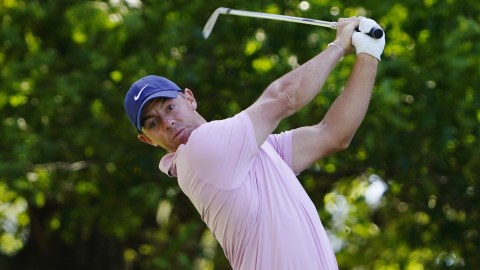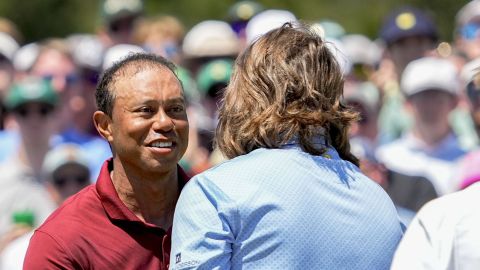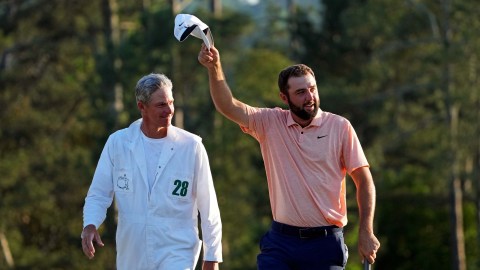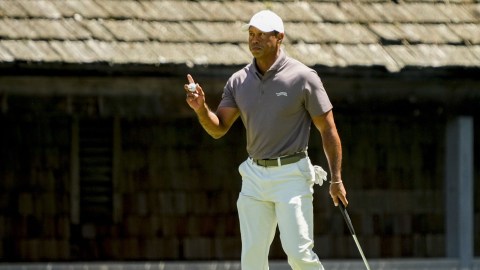 BROOKLINE, Mass. — As if the pressure the field of 312 golfers participating in this year’s U.S. Amateur isn’t high enough, they’ll be facing historic pressure at one of the nation’s first golf courses.
BROOKLINE, Mass. — As if the pressure the field of 312 golfers participating in this year’s U.S. Amateur isn’t high enough, they’ll be facing historic pressure at one of the nation’s first golf courses.
One-hundred years ago in 1913, at The Country Club in Brookline, Mass., local lad Francis Ouimet, who lived across the street from TCC, took the golf world by storm by winning the U.S. Open. The 20-year-old topped Brits Harry Vardon and Ted Ray in an 18-hole playoff to put American golf on the front page of newspapers across the country.
Ouimet, who could see 17th hole from his bedroom, birdied the difficult par 4 to get into the three-way playoff. He would birdie that same hole the next day, which was a turning point in his winning round over golf’s two biggest superstars of the day.
But Ouimet wasn’t the only one to make history on the 17th hole, as it was there in 1999 when Justin Leonard and the United States Ryder Cup team would shock the golf world, yet again, in three memorable steps: Chip. Putt. Celebrate.
And now it’s the nation’s best amateurs aiming to make history at the club, which was founded in 1882 for horseback-riding. But this course has come a long way since the ponies grazed the grounds. In fact, the USGA made some major changes to the course to test the mettle and strength of this year’s field.
The back 9 eats up 3,962 yards of 7,310 total yards in this year’s par 70 layout and it’s the back 9 where the field will have to play its best and smartest golf. The ninth hole is a converted par 4 that will play 505 yards. The revamped 12th hole is a 623-yard par 5 behemoth. The 14th hole is yet another converted par 4 that will be 508 yards.
“For those that start on the ninth hole during the championship, I wish them the best of luck,” said Ben Kimball, the USGA’s director of the 2013 US Amateur. “That stretch of golf holes could be the hardest that I’ve seen at a US Amateur in a number of years.
“The goal of the U.S. Amateur is to identify the best player on a great golf course under difficult conditions,” Kimball added.
Needless to say, Kimball and the USGA certainly found their course.
Charles River Country Club will serve as the companion stroke-play qualifying course.
Check out more information on the tournament below, via USGA.org.
PAR AND YARDAGE: The Country Club will be set up at 7,310 yards and will play to a par of 34-36–70. The companion stroke-play qualifying course, Charles River Country Club will be set up at 6,574 yards and will play to a par of 35-35–70.(All yardages subject to change)
THE COUNTRY CLUB HOLE BY HOLE:
| Hole | 1 | 2 | 3 | 4 | 5 | 6 | 7 | 8 | 9 | Total |
| Par | 4 | 3 | 4 | 4 | 4 | 4 | 3 | 4 | 4 | 34 |
| Yards | 490 | 192 | 448 | 338 | 494 | 310 | 196 | 375 | 505 | 3,348 |
| Hole | 10 | 11 | 12 | 13 | 14 | 15 | 16 | 17 | 18 | Total |
| Par | 4 | 4 | 5 | 4 | 4 | 4 | 3 | 4 | 4 | 36 |
| Yards | 476 | 443 | 623 | 438 | 508 | 491 | 179 | 371 | 433 | 3,962 |
CHARLES RIVER COUNTRY CLUB HOLE BY HOLE:
| Hole | 1 | 2 | 3 | 4 | 5 | 6 | 7 | 8 | 9 | Total |
| Par | 4 | 5 | 4 | 3 | 4 | 4 | 4 | 4 | 3 | 35 |
| Yards | 420 | 501 | 373 | 152 | 390 | 354 | 484 | 427 | 179 | 3,280 |
| Hole | 10 | 11 | 12 | 13 | 14 | 15 | 16 | 17 | 18 | Total |
| Par | 4 | 3 | 4 | 4 | 3 | 5 | 5 | 3 | 4 | 35 |
| Yards | 469 | 243 | 350 | 348 | 192 | 505 | 558 | 188 | 441 | 3,294 |
ARCHITECTS: The Country Club evolved as a collaborative design. In 1893, the first six holes were designed by the club’s first golf committee, which comprised members Arthur Hunnewell, Laurence Curtis and Robert Bacon. Willie Campbell was hired as the professional in 1894 and helped add three new holes and redesign the original six. The club expanded to 18 holes in 1899. William Flynn designed a third nine in 1927, which is called Primrose.
The course used for championships, including the 2013 U.S. Amateur, is a composite that incorporates three-and-a-half holes from the Primrose. Geoffrey Cornish made changes before the 1963 U.S. Open. Rees Jones supervised revisions to the course before the 1988 U.S. Open. Gil Hanse has also done some recent restoration to the course. Charles River Country Club was designed by Donald Ross and opened in 1921.
COURSE SETUP: Green speeds are expected to be between 10.5 and 11 feet on the Stimpmeter at The Country Club and 10.5 to 11.5 feet at Charles River. The first cut of primary rough (15- to 20-foot width) will be 3 inches, while the second cut of primary rough will be 4 to 5 inches. The primary rough at Charles River will be 3.5 inches.
WHO CAN ENTER: The USGA accepted 7,002 entries for the 2013 championship, which was 599 more than in 2012. The record for entries is 7,920, in 1999. The 7,002 entries is the most since the 2008 U.S. Amateur at Pinehurst No. 2 (7,298).
SECTIONAL QUALIFYING: Sectional qualifying, played over 36 holes, will be held between July 13-30. The deadline for entries is June 26. The number of qualifying sites has yet to be determined.
SCHEDULE OF PLAY: A field of 312 players will play 18 holes of stroke play on Aug. 12 and 13, after which the field will be cut to the low 64 scorers. Six rounds of match play begin on Aug. 14 and the championship concludes with a scheduled 36-hole championship match on Aug. 18.
TICKETS
Tickets are on sale by clicking here
Tickets are $25 (single-day grounds) online or $30 on-site. Other passes and packages are available.
THE WINNER RECEIVES: Among the benefits enjoyed by the U.S. Amateur winner are:
1) A gold medal and custody of the Havemeyer Trophy for the ensuing year
2) An exemption from local and sectional qualifying for the next U.S. Open
3) An exemption from qualifying for the next 10 U.S. Amateurs
4) An exemption from qualifying for the next British Open Championship
5) A likely invitation to the next Masters Tournament
HISTORY: This is the 113th U.S. Amateur Championship. The U.S. Amateur Championship is the oldest golf championship in this country, one day older than the U.S. Open. Except for an eight-year period, 1965-1972, when it was contested at stroke play, the Amateur has been a match-play championship.
Throughout its history, the U.S. Amateur has been the most coveted of all amateur titles. Many of the great names of modern professional golf, such as Arnold Palmer, Jack Nicklaus, Lanny Wadkins, Craig Stadler, Jerry Pate, Mark O’Meara, Hal Sutton, Phil Mickelson and Tiger Woods, grace the Havemeyer Trophy.
It was, however, legendary amateur Robert T. Jones Jr., who first attracted national media coverage and sparked spectator attendance at the U.S. Amateur. Jones captured the championship five times (1924, 1925, 1927, 1928 and 1930). His 1930 victory was a seminal moment in golf history Jones won the four major American and British championships in one year and completed the Grand Slam by winning the U.S. Amateur at Merion Cricket Club in Ardmore, Pa.
Sixty-six years later, in 1996, Tiger Woods attracted similar levels of interest and enthusiasm at Pumpkin Ridge Golf Club in North Plains, Ore., when he won a record third straight U.S. Amateur, having registered 18 consecutive match-play victories. In 1994, Woods, at 18, had first entered the record book as the youngest U.S. Amateur champion, following his three consecutive Junior Amateur titles (1991-1993). That record has since been broken twice, first by 17-year-old Danny Lee in 2008 at Pinehurst No. 2 in the Village of Pinehurst, N.C., then in 2009, when 17-year-old Byeong-Hun An won at Southern Hills Country Club in Tulsa, Okla., with a 7-and-5 victory over Ben Martin, of Greenwood, S.C.
2012 CHAMPION: Steven Fox, 21, of Hendersonville, Tenn., made an 18-foot birdie putt on the 37th hole to defeat Michael Weaver, 21, of Fresno, Calif., at Cherry Hills Country Club, near Denver Colo. Fox, who like Weaver advanced to match play as one of 14 survivors of a 17-man playoff earlier in the week, became the lowest seed, No. 63, to win the U.S. Amateur since the USGA began the seeding process in 1985. Fox became the first to win the Amateur after advancing through a playoff since Italy’s Edorardo Molinari in 2005.
USGA AT THE COUNTRY CLUB: The Country Club has hosted five U.S. Amateurs and three U.S. Opens. In 1982, Jay Sigel won the first of two consecutive Amateur championships. This is the 100th anniversary of amateur Francis Ouimet’s historic U.S. Open win over Harry Vardon and Ted Ray. The champions in all three Opens at The Country Club won in playoffs, including Julius Boros in 1963 and Curtis Strange in 1988.
Photo via 2013usamateur.com



